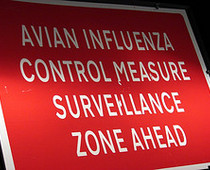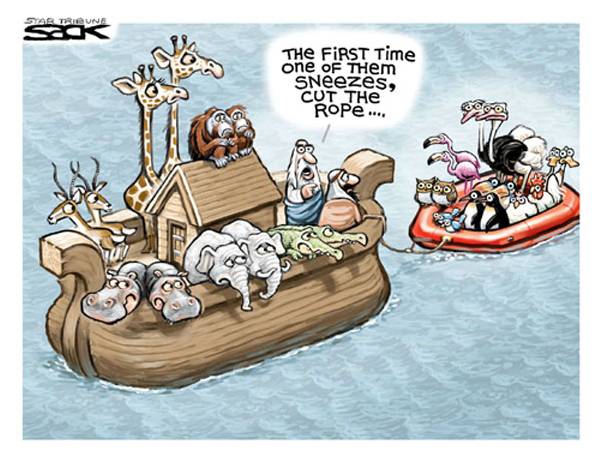Section 4. Recovery
| Site: | Extension Foundation Online Campus |
| Course: | Avian Influenza Biosecurity for Backyard Flock Owners |
| Book: | Section 4. Recovery |
| Printed by: | Guest user |
| Date: | Thursday, December 25, 2025, 11:42 PM |
Description
1. Quarantine Release
2. Indemnification
3. Changes
4. Summary
Release a Quarantine
By the end of this section, you should know the requirements for returning to a disease free state and recovering from financial losses.

Continuous monitoring and testing for avian influenza are required before an area can be released from quarantine.3
- Once decontamination is complete, the infected premises must have a downtime of 42 days or until sampling shows negative results for AI virus.
- Downtime is a period of time immediately after a premises has been cleaned and disinfected in which poultry areas are left empty and unused so they can dry completely.
- Downtime is absolutely essential because even after a thorough cleaning and disinfection effort, some viral particles are likely to remain. Dry surfaces create a less favorable environment for viral survival and growth, thus forcing the pathogens to decline to a point where susceptible animals have a slim to no chance of infection.
- Release of infected premises from quarantine requires that all surrounding areas are also eligible for quarantine release.
- Credit for photo on right: Incessant Flux
Evaluating an Indemnification Program
The Animal Health Protection Act gives the USDA APHIS authority to establish and implement an indemnification program to prevent or eradicate an HPAI outbreak.
Indemnity is part of the disease control program that provides fair compensation to owners for their financial losses due to eradication of AI infected birds. Appraisal of the fair market value of birds is estimated using several factors that consider the purpose for which the animal is being reared as well as its age, breed, physical condition, and potential production.3
Appraisal Procedures
- USDA indemnity is not certain. It is subject to funding.
- USDA compensates up to 100% of losses from a highly pathogenic avian influenza outbreak. The standard rate for low pathogenicity avian influenza is 50% of fair market value.
- Some industry associations, such as those on the Delmarva peninsula (Delaware, Maryland, and Virginia), have their own compensation funds. Check with your state for supplemental compensation for losses during an outbreak.
Appraisal Procedures
- A foreign animal disease diagnostician (FADD) will determine if domestic birds are infected or exposed to HPAI virus.
- The FADD will conduct a preliminary inventory of birds and materials that will need to be assessed and managed.
- Next, an Appraisal Unit Leader will discuss any high value birds with the owner before an appraisal team is sent to the premises.
- In general, domesticated birds and other livestock will be appraised first and materials such as feed will be appraised last.
- In most cases, appraisal is performed prior to depopulation.
For more information on Avian Influenza Indemnity Program click here.
Compensation in an Indemnification Program
Allowable Claims Include the Following3
USDA Will Not Allow Claims Involving the Following
- Domesticated birds and other livestock destroyed due to infection or exposure to HPAI virus.
- Materials destroyed due to contamination or exposure to HPAI virus.
USDA Will Not Allow Claims Involving the Following
- A payee who has not complied with all quarantine requirements.
- Expenses for the care and feeding of domesticated birds and other livestock held for destruction.
- The destruction of domesticated birds and other livestock or materials unless these have been appraised as described in Part II, Section J, or the owner has signed the VS Form 1-23.
- The destruction of domesticated birds and other livestock or materials that have been moved or handled in violation of a law or regulation.
Needed Modifications
All bird owners in the area, including unaffected owners, should evaluate their actions following an avian influenza outbreak. Review flock setup and biosecurity practices to determine what led to the spread of disease and then establish steps to prevent it from occurring again.
Needed Modifications May Include the Following
Needed Modifications May Include the Following
- Cleaning and disinfecting bird houses and equipment more often or more effectively
- Wash hands and clothes more often
- Separate birds by species and age
- Change waste disposal methods
Summary of Recovery
The United States is the world's largest producer and exporter of poultry meat and the second largest egg producer. According to 2009 USDA statistics, U.S. poultry meat production totals more than 43 billion pounds annually. U.S. egg operations produce more than 90 billion eggs annually, valuing the U.S. poultry industry at $29 billion a year.
The economic effects of any avian influenza outbreak can be devastating, not only for owners but to a city, state, and country as trade bans may be imposed. Response measures ranging from staffing and testing to depopulation, disposal, and decontamination procedures, are expenses that may also affect the economy. During the 1983-84 outbreak of highly pathogenic avian influenza in the Mid-Atlantic region, 17 million birds were euthanized and damages totaled $65 million.23
You are the first line of defense for your birds and practicing good biosecurity makes you the most important protection your birds have. Remember to isolate your birds, control traffic, and keep your area clean. These steps will greatly increase your success in maintaining a happy healthy flock.

Avian Influenza Cartoon by Steve Sack
The economic effects of any avian influenza outbreak can be devastating, not only for owners but to a city, state, and country as trade bans may be imposed. Response measures ranging from staffing and testing to depopulation, disposal, and decontamination procedures, are expenses that may also affect the economy. During the 1983-84 outbreak of highly pathogenic avian influenza in the Mid-Atlantic region, 17 million birds were euthanized and damages totaled $65 million.23
You are the first line of defense for your birds and practicing good biosecurity makes you the most important protection your birds have. Remember to isolate your birds, control traffic, and keep your area clean. These steps will greatly increase your success in maintaining a happy healthy flock.

Avian Influenza Cartoon by Steve Sack
Hands on Practice
Want to get some hands on practice? Then come have some fun with our online Backyard Flock. You must be 16 or older to use this resource. Check out the video below for more details or visit the site yourself, here.